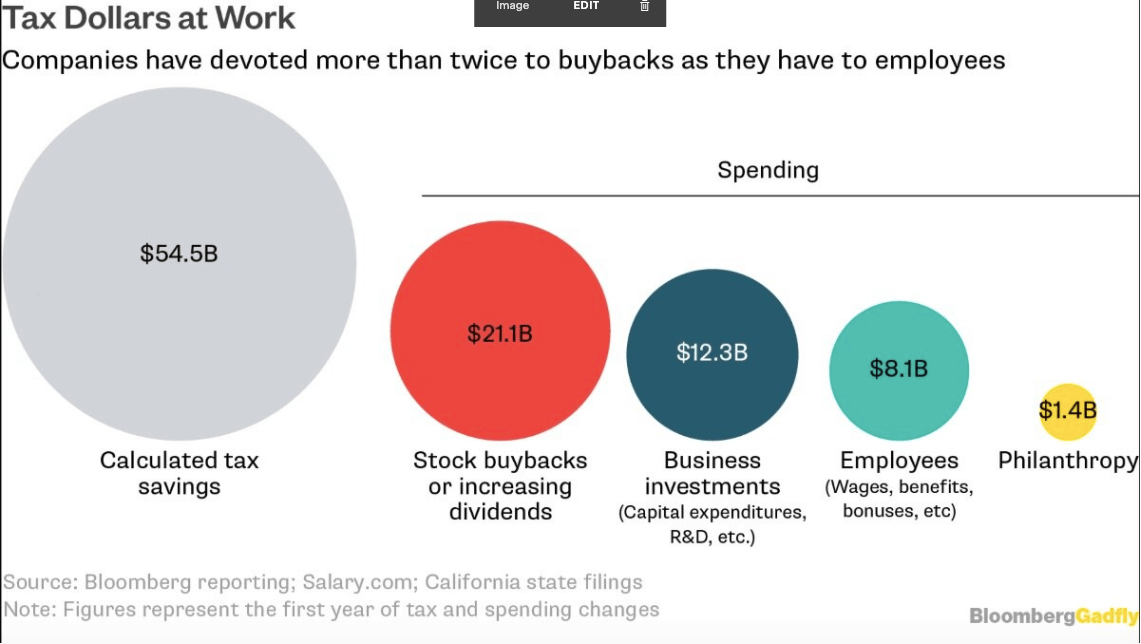Boeing’s 737 Max issues highlighted the company’s sacrifice of safety for financial performance, resulting in a tarnished reputation. The prioritization of profit over core values also damaged the FAA’s credibility and revealed a lack of accountability for top executives. This downfall serves as a reminder of the importance of maintaining core values and prioritizing them over short-term financial gains.

To Buyback or Not Buyback, That is the Question?
As part of The CARES Act, Congress imposed restrictions on stock buybacks. There was bipartisan support for this idea. Billionaire Mark Cuban argued that the rule for any company that receives federal assistance is, “No buybacks. Not now. Not a year from now. Not 20 years from now. Not ever.” Senate Minority Leader Chuck Schumer declared on-air: “Our motto in this is ‘workers first.’ …. These buybacks, they infuriate me. We should not be allowing them to do buybacks, raise corporate salaries.” Sen. Elizabeth Warren said that any corporate recipient of government assistance should be “permanently prohibited from engaging in share repurchases.” President Trump joined the chorus arguing, “I am strongly recommending a buyback exclusion. You can’t take a billion dollars of the money and just buy back your stock and increase the value.” However, others have argued that this policy is “The Worst Coronavirus Idea.”
How it Happened
The airline industry was the poster child for arguments against buybacks. Airlines for America, which represents major U.S. passenger and cargo air carrier companies, requested government assistance because of (i) the coronavirus crisis, and (ii) several of the largest carriers had used the majority of their free cash flow on share buybacks over the last decade. Given that airlines have a propensity for going bankrupt with over 60 since 1991, and being unprepared for hard times including the Sept. 11, 2001, attacks and the volcanic eruption in Iceland in 2010 that disrupted air travel, building up cash for a rainy day hasn’t been part of their plan.
| Airline | Free Cash Flow ($MM) | Share Buybacks ($MM) | Buybacks/FCF |
|---|---|---|---|
| Southwest Airlines Co. | 15,103 | 10,650 | 71% |
| Alaska Air Group, Inc. | 4,948 | 1,590 | 32 |
| Delta Air Lines, Inc. | 23,186 | 11,430 | 49% |
| United Airlines Holdings, Inc. | 11,526 | 8,883 | 77% |
| American Airlines Group, Inc. | (7,935) | 12,957 | N/A |
| JetBlue Airways Corporation | 2,347 | 1,771 | 75% |
Source: FactSet
However, airlines weren’t the only ones spending free cash flow on share buybacks. As can be seen below, nearly 50% of the saving from the 2017 Tax Cut and Jobs Act went to share buybacks.

Arguments For Buybacks
Share buybacks are very popular. According to Federal Reserve data compiled by Goldman Sachs, over the past nine years, corporations have acquired more of their stocks – $3.8 trillion—than every other type of investor (individuals, mutual funds, pension funds, foreign investors) combined. So why do they do it?
-
An efficient way to return money to shareholders. By reducing the number of shares outstanding in the market, a buyback lifts the price of each remaining shares.
-
A Valuable source of cash. Donald L. Luskin and Chris Hynes made this argument in a Wall Street Opinion Editorial. It has to be the worst reason I have heard. If people need cash, they can sell their shares on the market; they don’t need the company to repurchase them.
-
More tax-efficient than dividends. If the shareholder has held the shares long enough to qualify for long term capital gains treatment, this is true. Dividends are taxed at 22% while the tax rate for capital gains is 0%,15%, or 20% depending on the taxpayers’ level of income.
-
Management captures the share bump. An analysis by the SEC revealed that executives, on average, sold five times as much stock in the eight days following a buyback announcement as they had on an ordinary day. According to SEC Commissioner Robert Jackson Jr., “Thus, executives personally capture the benefit of the short-term stock-price pop created by the buyback announcement.”
-
Boost management’s compensation. Following the adoption of Milton Friedman’s idea of “creating shareholder value,” more and more companies granted CEOs large blocks of company stock and stock options to align management with the corporate goal. However, with large portfolios of their own company’s stock, the desire to manipulate the share price with share buybacks was a temptation few CEOs could resist. As a recent article noted, “Today, the abuse of stock buybacks is so widespread that naming abusers is a bit like singling out snowflakes for ruining the driveway.”
Arguments Against Buybacks
-
Deprives companies of liquidity. As a recent Harvard Business Review article noted, when companies undertake buybacks, they deprive themselves of the cash that might help them cope when sales and profits decline in an economic downturn.
-
The share price boost is short-lived. A study by the research firm Fortuna Advisors found that five years out, the stocks of companies that engaged in substantial buybacks performed worse for shareholders than the shares of companies that didn’t.
-
The propensity to buy when the price is high and not when it’s low. Companies tend to overpay for their shares, diluting return to shareholders. The is overwhelming evidence that substantial buyback companies usually create less value for shareholders over time.
-
Lack of investment in things that grow shareholder value. Those companies that reinvested a higher percentage of their cash generation into capital expenditures, research and development, cash acquisitions, and working capital delivered substantially higher total shareholder return than those that reinvested less.
-
Lack of Imagination by Management. If the best use of the company’s money is share buybacks, then unless the shares are undervalued (20%+), management has effectively given up on planning to grow the company in new markets or products, through acquisition or investment. Such a strategy is a reflection of failed management.
Conclusion
From the above, it is apparent that there are few good reasons for share buybacks other than to boost management’s earnings. Hopefully, the current environment will cause management to reflect and do their jobs more efficiently so that there is real shareholder growth. As the Atlantic article pointed out.
“Craig Menear, the chairman and CEO of Home Depot mentioned on a conference call with investors in February 2018, their “plan to repurchase approximately $4 billion of outstanding shares during the year.” The next day, he sold 113,687 shares, netting $18 million. The following day, he was granted 38,689 new shares and promptly sold 24,286 shares for a profit of $4.5 million. Though Menear’s stated compensation in SEC filings was $11.4 million for 2018, stock sales helped him earn an additional $30 million for the year.
By contrast, the median worker pay at Home Depot is $23,000 a year. If the money spent on buybacks had been used to boost salaries, the Roosevelt Institute and the National Employment Law Project calculated, each worker would have made an additional $18,000 a year. But buybacks are more than just unfair. They’re myopic. Amazon (which hasn’t repurchased a share in seven years) is presently making the sort of investments in people, technology, and products that could eventually make Home Depot irrelevant. When that happens, Home Depot will probably wish it hadn’t spent all those billions on buying back 35 percent of its shares. “When you’ve got a mature company when everything seems to be going smoothly, that’s the exact moment you need to start worrying Jeff Bezos is going to start eating your lunch,” said the shareholder activist Nell Minow.”
Copyright (c) 2020, Marc A. Borrelli
Recent Posts
The Downfall of Boeing: A Lesson in Core Values
Resolutions, Here We Go Again.
In reflecting on 2021 resolutions, the author scored themselves in three categories and sought to improve success in 2022 by addressing friction points. Drawing on advice from social psychologist Wendy Wood, the author identified areas to reduce or increase friction in their failed resolutions. By making these adjustments, the author aims to enhance their goal achievement and encourages others to consider friction when setting resolutions.
You need to take an extended vacation. No, seriously, you do.
COVID has taken a toll on all of us. If you have not taken an extended vacation in a while where you disconnect, you need to now. You and your business will benefit.
Becoming Famous in Your Niche: The Success Story of Linn Products Limited
In a previous discussion, I highlighted the importance of being famous for something. Being well-known in your niche can help you: Concentrate on your strengths Connect with your target audience Communicate your offerings more effectively Receive referrals Identify...
Understanding and Optimizing Your Cash Conversion Cycle
Understanding and optimizing the Cash Conversion Cycle is crucial for business growth, as it impacts cash flow and the ability to access external capital. This cycle consists of four components: Sales, Make/Production & Inventory, Delivery, and Billing and Payments. To improve the Cash Conversion Cycle, companies can eliminate mistakes, shorten cycle times, and revamp their business models.
Discovering Your Niche: Why You Need to Be Famous for Something
As an entrepreneur, it’s crucial to specialize in a specific area and become famous for something, allowing you to generate referrals and build your brand. Understanding the “job” you’re hired for helps you stand out in the marketplace and communicate your value proposition effectively. By providing value to your clients, you can adopt a value-based pricing approach, ensuring your business remains competitive and maintains a strong market presence.
Rethinking Your Pricing Model: Maximizing Margins and Providing Value
Rethink your pricing model by focusing on the value you provide and your customers’ Best Alternative To a Negotiated Agreement (BATNA). This approach can help you maximize margins while delivering better value to your clients. Assess your offerings and brainstorm with your team to identify pricing adjustment opportunities or eliminate commodity products or services.
Do you know your Profit per X to drive dramatic growth?
I recently facilitated a workshop with several CEOs where we worked on the dramatic business growth model components. One of the questions that I had asked them beforehand was, "What is Your Profit/X?" The results showed that there this concept is not clear to many....
The War for Talent: 5 Ways to Attract the Best Employees
In today’s War for Talent, attracting the best employees requires a focus on value creation, core customer, brand promise, and value delivery. Clearly articulate your company’s mission, identify your “core employee” based on shared values, and offer more than just a salary to stand out as an employer. Utilize employee satisfaction metrics and showcase your company’s commitment to its workforce on your website to make a strong impression on potential candidates.
Are you killing your firm’s WFH productivity?
Productivity remained during WFH with COVID. However, further analysis found that hourly productivity fell and was compensated for by employees working more hours. What was the culprit – Meetings. Want to increase productivity, have fewer meetings.












